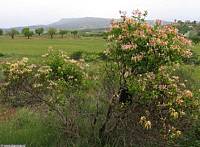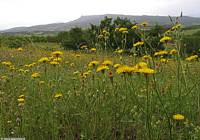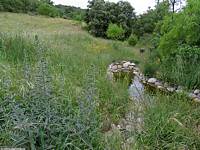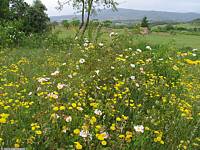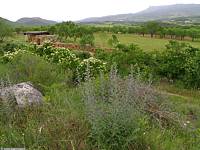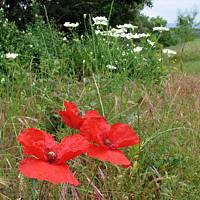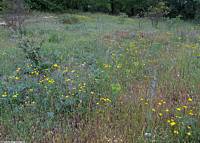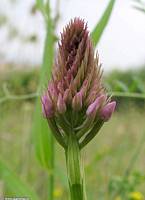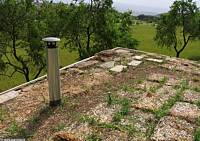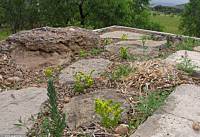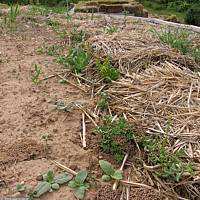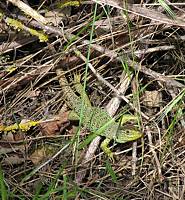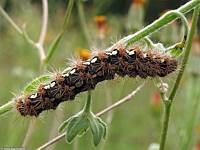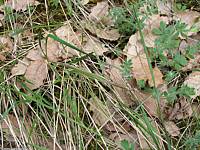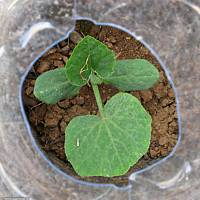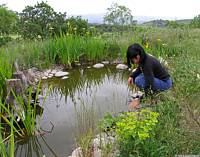|
|
Nature
Switched On
|
|
|
introduction Lonicera
etrusca with a flowerpot filled with straw to attract
earwigs that eat aphis. |
2009 May 23 & 24, Saturday & Sunday
The very wet spring has remarkable effects on
the vegetation. I have already mentioned
the explosion of
French Hawk's-beard (Crepis nicaeensis)
but other species are also doing exceptionally well.
Honeysuckles (Lonicera) are flowering like never before and are much less
affected by aphis than other years. Some plants of Viper's Bugloss
(Echium vulgare) have grown to unusual large
proportions.
|
Crepis nicaeensis on the central terrace. |
|
Robust Echium vulgare near the lower pond. Looking north-west. Saturday 10:14 |
Crepis nicaeensis
and Rosa canina on the central terrace. Looking north. Sunday 11:05 |
|
|
Echium vulgare on the foreground, white flowering
Cornus sanguinea on the left. Looking north. Saturday 9:27 |
Rosa canina on the
central terrace. Looking north-east. Saturday 10:17 |
|
|
Pure red is not a very common colour for flowers. The Red Poppies (Papaver rhoeas) stand all the more out, but are not very abundant this year.
|
||
|
Papaver rhoeas with Orlaya grandiflora on
the background. Central terrace, looking south-east. Sunday 11:23 |
Nice palette of subtle colours on the higher terrace. |
|
|
Orchids are also doing very fine this season. I detected 4 plants of Woodcock Orchid (Ophrys scolopax) on a new location on the lower terrace. |
||
| Ophrys
scolopax. Saturday 16:17 |
Towering inflorescence of
Anacamptis pyramidalis. Saturday 15:57 |
|
|
A diversity of species is germinating and growing on the green roof of the
garden house. I cut
all the stalks of the Barley plants with some garden scissors to
avoid the setting of its seed and stimulate horizontal growth. Goldmoss Stonecrop (Sedum acre) and Wooly yarrow (Achillea
tomentosa) started flowering.
|
||
|
Green roof with chimney. Looking east. Sunday 9:50 |
||
|
Sedum album, Sedum anglicum and Sedum acre
along the 'path'. |
Yellow Sedum acre
and red Fumaria officinalis flowering between the
stones that were laid to balance the weight of the roof. Sunday 9:34 |
|
|
A juvenile Ocellated Lizard (Timon lepidus) was
sunbathing near the caravan. It was not too shy and when we
approached the animal, it started a kind of hide-and-seek game.
|
||
|
Ocellated lizard in the brambles near the caravan. Sunday 14:25 |
This must be the caterpillar of Rhyparia purpurata,
a night-moth, eating on Cynoglossum creticum. |
|
|
In the centre of the picture, head-down, you will find the
Praying mantis. Saturday 15:45 |
||
|
In the vegetable garden the results so far are quite mixed. Straw is
still playing an important role and not always a beneficial one. In
(early) spring it is doing probably more harm than good. These are
the three mayor problems:
The advantages are not to be neglected though. It protects and
stimulates soil life, suppresses effectively undesired weeds and
retains humidity. |
||
|
Seedling of a pumpkin (Cucurbita
maxima 'Butternut') under a plastic water bottle. Sunday 10:28 |
||
|
This kiwi plant was severely frozen in
early spring but
recovered remarkably. Sunday 10:32 |
||
|
|
||
|
Blanca at the pond. In the foreground, flowering Lolium perenne and Euphorbia cyparissias. Saturday 19:14 |
||
|
introduction
|
|
